
Falling Techniques -- It's not ALL good!
Some "Safe Falling" techniques are NOT effective for the elderly.
There is much advice now appearing on the internet about "how
to fall safely," and while most is good in general
principles, there are some specific techniques that are useless, or
even dangerous, for the older adult who falls. Any useful method has to
allow for the physiological startle response that controls our body for
the first fractions of a second and, especially for older
adults, should not require a lot of speed, strength and flexibility.
Note: if you have previous training in these methods, don't try to
"unlearn" them, but don't reinforce them or pass them on to older
unskilled adults.
Specific problematic suggestions and techniques:
1. "Just go limp."

Even if you could instantly will yourself to go limp,
letting your neck go loose can result in serious head or face
injuries: the whipping head strike is the major cause of fatal injury
in a floor-level fall. Also, loose joints can be easily
dislocated when the legs and
arms hit the ground. Going truly limp, if you pass out while
standing, for example, is
very dangerous. The stories of drunks surviving accidents and
falls due to their limp bodies are just that -- unusual stories. What
this advice really means is to RELAX: don't go completely rigid and
fight the fall. Stiffly throwing a hand out to stop your fall is an
instinctive startle response which must be moderated. But to physically overcome the stiffening startle response an active, not passive, mindset is
needed. You actively relax by deliberately sitting down and curling up while protecting
your head.
2. "Reach out with your hands to guide your fall."
This works for expert stuntmen and martial artists in controlled
falls, but not as well for the average person. Our instinct is to
rigidly STOP the fall with our hands, not guide it, leading to the
common broken wrist injury. The Fearless Falling system does use a quick
slapping motion with the hands and forearms when falling directly forward to
absorb some of the force and protect the face. The action is
springy and close to the body and face, not extended and stiff.
Which brings us to:
3. "Slap the ground with your arm(s) to absorb the shock."
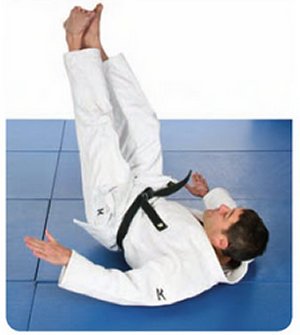
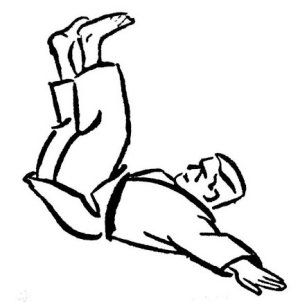
(Note: the line drawing above shows a very bad angle for the arm!)
The "taking a beat" slapping of the mat is a traditional rear or side
falling
technique used in judo, jujutsu, and many other Asian martial arts.
Practitioners can testify that it definitely FEELS better to slap the
mat when taking a hard fall to the side or rear, but the few studies
that have actually
measured acceleration forces on the body have found minimal direct
effect. The
pre-tensioning of the body to slap hard probably braces the joints and
acts to spread forces more evenly, reducing discomfort, especially
over multiple training falls. Regardless, the slapping
of the ground method requires very tight timing for any useful effect.
In the practice hall with your partner, falls may be sudden, but
they are expected. In a quick accidental side or back fall, slapping
with perfect timing
is unlikely even for a trained person. If you slap too early, you
may break the wrist or arm: too late and the elbow may hit and
hyper-extend. And the ground outside is likely to be hard and uneven
with curbs and debris. Also, as noted above, swinging the arm back past
the correct 45 degree angle to the body is bad and can seriously
injure the shoulder joint. It is much simpler and safer to always pull
the arms in to protect the head on a back or side fall.
4. "Turn your head to the side in a front fall."
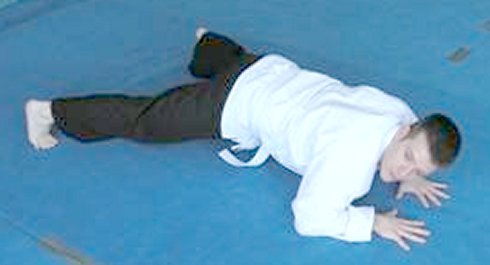 While
moving your face away from a hard surface
is a good idea, this is another method that is more suited to the
gymnasium than real life. In the gym, it protects students from bumping
their noses into the soft mat while learning. There are two issues
here: first, forward
tripping falls are among the fastest falls. When you are
startled your neck immediately tenses up, and relaxing the neck
muscles enough to twist your
face suddenly to the side would be difficult. The second issue is
that rapidly twisting the cervical vertabrae and then having that
twisted section of the upper spine bent as
the weight of the head is whipped down is dangerous. You are also
commonly
instructed
to tense up to keep your legs and body off the ground. But, in a quick
trip forward, you are
usually already on your
knees when you realize you are falling, and having enough core strength
to support a "plank" position is unlikely for an older adult.
While
moving your face away from a hard surface
is a good idea, this is another method that is more suited to the
gymnasium than real life. In the gym, it protects students from bumping
their noses into the soft mat while learning. There are two issues
here: first, forward
tripping falls are among the fastest falls. When you are
startled your neck immediately tenses up, and relaxing the neck
muscles enough to twist your
face suddenly to the side would be difficult. The second issue is
that rapidly twisting the cervical vertabrae and then having that
twisted section of the upper spine bent as
the weight of the head is whipped down is dangerous. You are also
commonly
instructed
to tense up to keep your legs and body off the ground. But, in a quick
trip forward, you are
usually already on your
knees when you realize you are falling, and having enough core strength
to support a "plank" position is unlikely for an older adult.
We advocate going with the
natural "baby arch" reflex: slap the ground away with your hands
and forearms as your
neck stiffens and pulls your face straight back. When the downward head
whip comes, the
spine is straight and the neck muscles are already tensed for support.
Exhale and let your forearms, chest, abdomen and thighs absorb the
force. The front of your body is soft and large: you are
not going to break any bones in your belly!
Here is the Fearless Falling "Slap the Cheese" front slap in action:
5. Use the paratrooper "Parachute Fall."
This is a common falling technique that is often suggested for young soccer and rugby players:
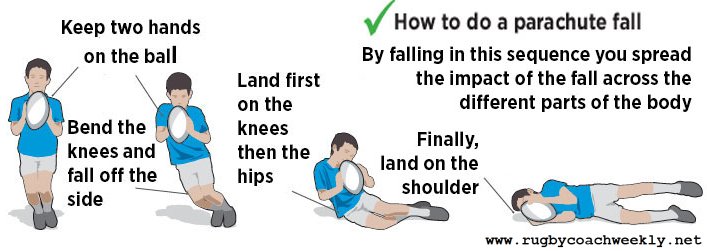
This is an old military
method and is not how the parachute fall is taught in the armed forces
today. The modern parachute fall does not land on the hips and
shoulders, but uses a slight turn
to land on the side of the butt and behind the shoulder. Also,
dissipating the shock from a vertical drop fall hitting the ground
with
the feet is different from a typical accidental fall where the feet are
already on
the ground, and the body is tipping over. The major benefit of this
method is to keep young players' hands on the ball instead of reaching
out to stop the fall. Young bodies on a turf field can normally absorb
the forces of this technique, but for an older adult on a hard surface
this
method will probably result in injured knees, a broken hip, or a
dislocated shoulder.
6. Overly elaborate and impractical techniques.
An example is this advice on how to handle a fall to the side:
For Side Falls
- Hit ground with entire palm and forearm on the side you fall on- If left side use left arm etc.
- Grab your hip with opposite arm- If falling to left use right arm to grab hip.
- Tuck your chin to your chest to avoid your head hitting the ground.
- Squat.
- Try to roll to your back.
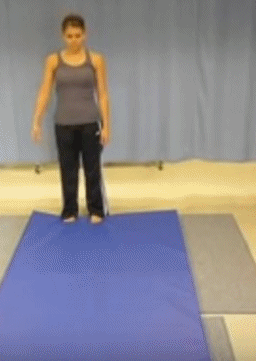 There
are several issues here. First, if you are falling to the left, your
left hip is dropping to the
side or rear, but here you reverse the natural direction and turn to
the front, flipping
onto your right hip and back instead. Grabbing the left hip with
the right
hand to force this turn and flip is both counter-intuitive and
dangerous: it leaves the head and
face exposed as you spin down in what is now a front fall,
with both hands down at waist-level where they cannot protect the
head or guide the rolling motion. As the turn continues, the right hip
and right
shoulder areas hit at about the same time, followed by a short roll
across
the lower back to the left side -- step five. The final slap on the
ground
with the left hand and forearm mentioned in step one is superfluous.
There
are several issues here. First, if you are falling to the left, your
left hip is dropping to the
side or rear, but here you reverse the natural direction and turn to
the front, flipping
onto your right hip and back instead. Grabbing the left hip with
the right
hand to force this turn and flip is both counter-intuitive and
dangerous: it leaves the head and
face exposed as you spin down in what is now a front fall,
with both hands down at waist-level where they cannot protect the
head or guide the rolling motion. As the turn continues, the right hip
and right
shoulder areas hit at about the same time, followed by a short roll
across
the lower back to the left side -- step five. The final slap on the
ground
with the left hand and forearm mentioned in step one is superfluous.
While the demonstrator ends up in a good side-fall position, it
requires a 360 degree angled spin and flip in a forward direction with initial impact very close to the
shoulder and hip joints, and a final arm slap that is not really needed.
Just doing steps three, four, and five as listed above would be much better: tuck, sit down and rock
back on your side. There is no reason to turn an easy side/back fall into a difficult front
flip/roll fall.
The Fearless Falling method for the same type of side or back fall looks like this:
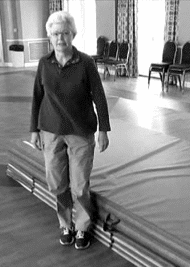





 While
moving your face away from a hard surface
is a good idea, this is another method that is more suited to the
gymnasium than real life. In the gym, it protects students from bumping
their noses into the soft mat while learning. There are two issues
here: first, forward
tripping falls are among the fastest falls. When you are
startled your neck immediately tenses up, and relaxing the neck
muscles enough to twist your
face suddenly to the side would be difficult. The second issue is
that rapidly twisting the cervical vertabrae and then having that
twisted section of the upper spine bent as
the weight of the head is whipped down is dangerous. You are also
commonly
instructed
to tense up to keep your legs and body off the ground. But, in a quick
trip forward, you are
usually already on your
knees when you realize you are falling, and having enough core strength
to support a "plank" position is unlikely for an older adult.
While
moving your face away from a hard surface
is a good idea, this is another method that is more suited to the
gymnasium than real life. In the gym, it protects students from bumping
their noses into the soft mat while learning. There are two issues
here: first, forward
tripping falls are among the fastest falls. When you are
startled your neck immediately tenses up, and relaxing the neck
muscles enough to twist your
face suddenly to the side would be difficult. The second issue is
that rapidly twisting the cervical vertabrae and then having that
twisted section of the upper spine bent as
the weight of the head is whipped down is dangerous. You are also
commonly
instructed
to tense up to keep your legs and body off the ground. But, in a quick
trip forward, you are
usually already on your
knees when you realize you are falling, and having enough core strength
to support a "plank" position is unlikely for an older adult.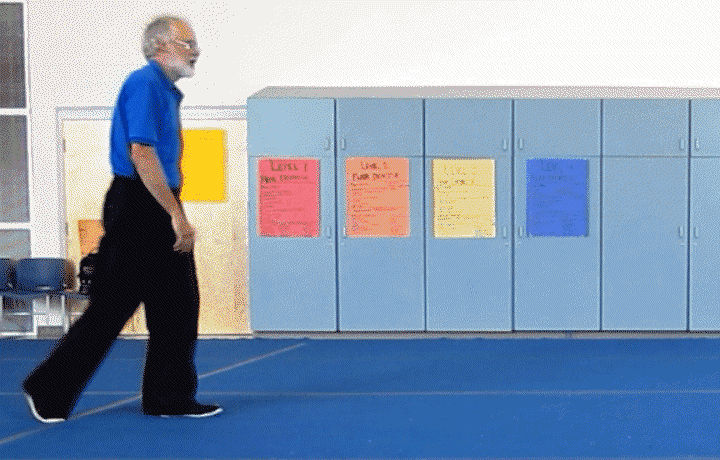

 There
are several issues here. First, if you are falling to the left, your
left hip is dropping to the
side or rear, but here you reverse the natural direction and turn to
the front, flipping
onto your right hip and back instead. Grabbing the left hip with
the right
hand to force this turn and flip is both counter-intuitive and
dangerous: it leaves the head and
face exposed as you spin down in what is now a front fall,
with both hands down at waist-level where they cannot protect the
head or guide the rolling motion. As the turn continues, the right hip
and right
shoulder areas hit at about the same time, followed by a short roll
across
the lower back to the left side -- step five. The final slap on the
ground
with the left hand and forearm mentioned in step one is superfluous.
There
are several issues here. First, if you are falling to the left, your
left hip is dropping to the
side or rear, but here you reverse the natural direction and turn to
the front, flipping
onto your right hip and back instead. Grabbing the left hip with
the right
hand to force this turn and flip is both counter-intuitive and
dangerous: it leaves the head and
face exposed as you spin down in what is now a front fall,
with both hands down at waist-level where they cannot protect the
head or guide the rolling motion. As the turn continues, the right hip
and right
shoulder areas hit at about the same time, followed by a short roll
across
the lower back to the left side -- step five. The final slap on the
ground
with the left hand and forearm mentioned in step one is superfluous. 